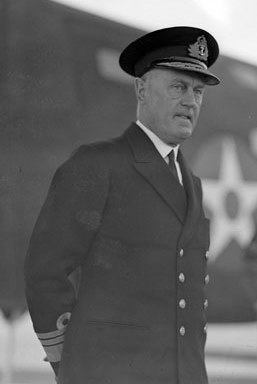
Vice-Admiral Sir Humphrey Thomas Walwyn, was an officer of the Royal Navy, who served during the Second Boer War and First World War, and was the Commander-in-Chief of the Royal Indian Navy from 1928 until his retirement in 1934. He then served as Governor of Newfoundland from 1936, throughout the Second World War, until 1946.

Admiral of the Fleet Peter John Hill-Norton, Baron Hill-Norton, was a senior Royal Navy officer. He fought in the Second World War as gunnery officer in a cruiser operating on the Western Approaches and in the North Sea taking part in the Norwegian Campaign, then in a cruiser taking part in the Arctic convoys and finally in a battleship operating in the Eastern Fleet. After the War he commanded a destroyer and then an aircraft carrier. He served as First Sea Lord and Chief of the Naval Staff and then Chief of the Defence Staff in early 1970s. In the latter role he gave the final commitment to Project Chevaline, the Polaris missile improvement programme. He went on to be Chairman of the NATO Military Committee.
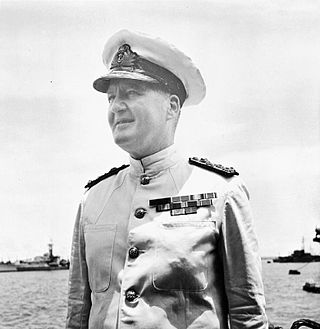
Admiral of the Fleet Bruce Austin Fraser, 1st Baron Fraser of North Cape, was a senior Royal Navy officer. He served in the First World War, saw action during the Gallipoli Campaign and took part in the internment of the German High Seas Fleet at the end of the war. He also served in the Second World War initially as Third Sea Lord and Controller of the Navy and then as second-in-command and afterwards as commander of the Home Fleet, leading the force that destroyed the German battleship Scharnhorst. He went on to be First Sea Lord and Chief of the Naval Staff in which role he assisted in establishing NATO and agreed to the principle that the Supreme Allied Commander Atlantic should be an American admiral, in the face of fierce British opposition.

Admiral Edmund Lyons, 1st Baron Lyons, was an eminent British Admiral of the Royal Navy, and diplomat, who ensured Britain's victory in the Crimean War, during which he was Commander-in-Chief of the Mediterranean Fleet, by his contribution at the Siege of Sevastopol (1854–1855) with both the Royal Navy and the British Army.
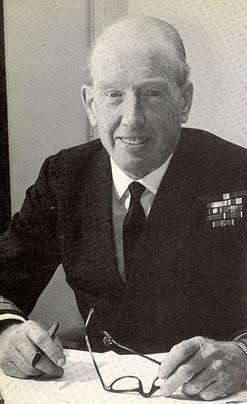
Admiral of the Fleet Sir Michael Le Fanu was a Royal Navy officer. He fought in the Second World War as gunnery officer in a cruiser operating in the Home Fleet during the Norwegian campaign and the Battle of the Mediterranean and then as gunnery officer in a battleship operating in the Eastern Fleet before becoming liaison officer between the British Pacific Fleet and the United States Third Fleet. After the War he commanded a frigate, a training establishment and an aircraft carrier. He served as First Sea Lord and Chief of the Naval Staff in the late 1960s. In that role, in the face of economic difficulties, he worked hard to reshape the Navy as an anti-submarine force operating primarily in the Atlantic Ocean.

Admiral of the Fleet Sir Algernon McLennan Lyons was a senior Royal Navy officer who served as First and Principal Naval Aide-de-Camp to Queen Victoria.
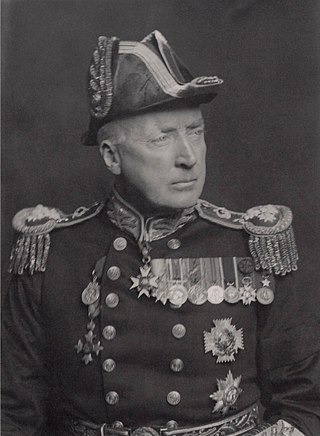
Admiral Sir Frederic Charles Dreyer, was an officer of the Royal Navy. A gunnery expert, he developed a fire control system for British warships, and served as flag captain to Admiral Sir John Jellicoe at the Battle of Jutland. He retired with the rank of admiral in 1943, having served through two world wars and having already retired once.
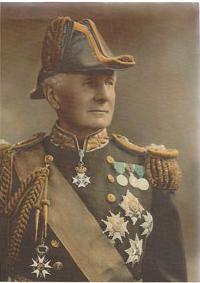
Admiral Sir Francis Charles Bridgeman Bridgeman was a Royal Navy officer. As a captain he commanded a battleship and then an armoured cruiser and then, after serving as second-in-command of three different fleets, he twice undertook tours as Commander-in-Chief of the Home Fleet with a stint as Second Sea Lord in between those tours. He became First Sea Lord in November 1911 but clashed with First Lord of the Admiralty Winston Churchill on technical issues as well as matters relating to a perceived overriding of naval traditions by Churchill: this led to Bridgeman's resignation just a year later.
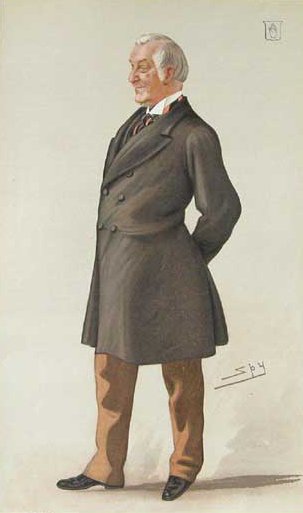
Sir John Eardley Eardley-Wilmot, 2nd Baronet was a politician and judge in the United Kingdom. He was Member of Parliament (MP) for South Warwickshire from 1874 to 1885.

Admiral Sir Sydney Colpoys Dacres was an officer of the Royal Navy who saw service during the Greek War of Independence, when he was involved in an attack on the Turkish forces at Morea, and later during the Crimean War. Born into a substantial naval dynasty during the Napoleonic Wars, he eventually rose to the rank of Admiral and became First Naval Lord. His only significant action as First Naval Lord was to press for the abolition of masts. He went on to be Visitor and Governor of Greenwich Hospital.

Vice-Admiral Kenneth Gilbert Balmain Dewar, CBE was an officer of the Royal Navy. After specialising as a gunnery officer, Dewar became a staff officer and a controversial student of naval tactics before seeing extensive service during the First World War. He served in the Dardanelles Campaign and commanded a monitor in home waters before serving at the Admiralty for more than four years of staff duty. After the war ended he became embroiled in the controversy surrounding the consequences of the Battle of Jutland. Despite this, he held a variety of commands during the 1920s.

Admiral of the Fleet Sir Osmond de Beauvoir Brock, was a Royal Navy officer. Brock served as assistant director of naval intelligence and then as assistant director of naval mobilisation at the Admiralty in the early years of the 20th century. During the First World War Brock commanded the battlecruiser HMS Princess Royal at the Battle of Heligoland Bight and at the Battle of Dogger Bank. He then commanded the 1st Battlecruiser Squadron with his flag in HMS Princess Royal at the Battle of Jutland.
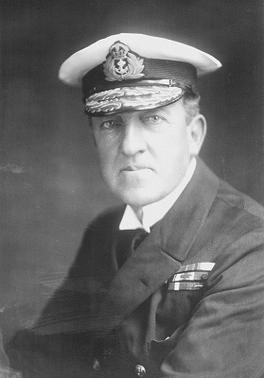
Admiral of the Fleet Sir John Donald Kelly was a Royal Navy officer. He served in the First World War as commanding officer of the cruiser HMS Dublin which came close to intercepting the German battlecruiser SMS Goeben. After the War he took charge of a naval force dispatched to strengthen the Mediterranean Fleet during the Chanak Crisis. After serving as Fourth Sea Lord and then commander of the 1st Battle Squadron, Kelly, known for his skill in personnel matters, was asked to take command of the Atlantic Fleet in the aftermath of the Invergordon Mutiny. He rapidly restored discipline and issued a report which was quite critical of the Admiralty Board's handling of the pay cuts issue in the first place. He went on to be Commander-in-Chief, Portsmouth.

Admiral Sir Arthur Cavenagh Leveson GCB was a senior officer in the Royal Navy. He was the Rear Admiral Commanding His Majesty's Australian Fleet from 9 January 1917 to 3 September 1918 and later Commander in Chief, China Station from 10 September 1922 to 22 April 1925.
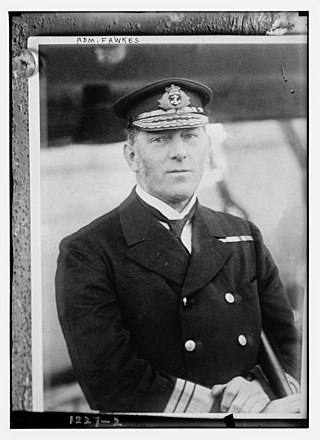
Admiral Sir Wilmot Hawksworth Fawkes, was a Royal Navy officer who went on to be Commander-in-Chief, Plymouth.

HMS Coquette was a two funnel, 30-knot destroyer ordered by the Royal Navy under the 1896 – 1897 Naval Estimates. She was the fifth ship to carry this name. She was launched in 1897, served in home waters before World War I, and as a tender to the gunnery school at Sheerness during the war. She was sold for breaking in 1920.
Admiral Sir Sidney Robert Bailey, was a Royal Navy officer who served as President of the Royal Naval College, Greenwich from 1937 to 1938.
HMS Dolphin was a screw sloop-of-war of the Royal Navy launched in 1882, used as school ship, and finally broken up in 1977.
Admiral Edward Leigh Stuart King CB, MVO was a British naval officer.
Vice-Admiral Sir Charles Hardy, also known as Sir Charles Hardy the Elder, was a Royal Navy officer of the eighteenth century. Hardy entered the Royal Navy in 1695, joining his cousin Captain Thomas Hardy's ship HMS Pendennis. Promoted to lieutenant in 1701, he served in several ships of the line before being promoted to commander in 1705. Hardy commanded sloops in the English Channel, Mediterranean and North Seas, before taking command of HMS Dunwich in 1709, in which he was promoted to post captain. Hardy subsequently served for a year at Jamaica before commanding two ships during the Great Northern War between 1718 and 1720. Having changed commands several times, in 1727 he fought at the thirteenth siege of Gibraltar in HMS Kent.
















